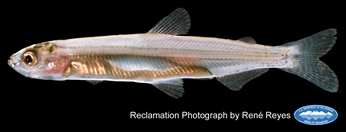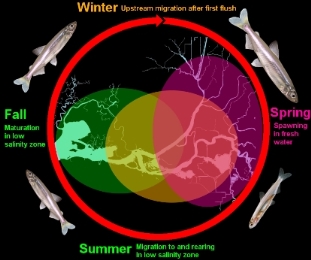Hypomesus transpacificus
Background
 Figure 1: Delta Smelt Juvenile. © Renee Reyes all rights reserved.
Figure 1: Delta Smelt Juvenile. © Renee Reyes all rights reserved.
 Figure 2: Delta Smelt Adult. © Renee Reyes all rights reserved.
Figure 2: Delta Smelt Adult. © Renee Reyes all rights reserved.
 Figure 3: Delta Smelt Female. © Renee Reyes all rights reserved.
Figure 3: Delta Smelt Female. © Renee Reyes all rights reserved.
 Figure 4: Delta Smelt Life Cycle and Migration (modified from IEP, 2015). Click to enlarge.
Figure 4: Delta Smelt Life Cycle and Migration (modified from IEP, 2015). Click to enlarge.
The Delta Smelt is a small fish, endemic to California that only occurs in the San Francisco Estuary. The slender-bodied fish typically reaches about 60-70 mm to a maximum size of about 120 mm (Figures 1, 2 and 3). The Delta Smelt life cycle follows the four seasons—spring spawning in fresh water, summer migration/rearing in the low salinity zone, fall maturation in the low salinity zone, and winter upstream migration shortly before spawning (Figure 4). Most spawning happens in tidally influenced backwater sloughs and channel edgewaters. Eggs are adhesive, and thought to be released in batches over firm substrates or sand. Delta Smelt is a euryhaline species, able to tolerate a wide salinity range.
Delta Smelt feeds primarily on planktonic copepods, cladocerans, and amphipods. Weak swimming behavior, combined with diel shifts up and down in the water column in response to tidal currents allows Delta Smelt to stay within limited regions, where planktonic food is also concentrated.
Species Status
Delta Smelt was listed as threatened under the Federal Endangered Species Act (ESA) and the California Endangered Species Act (CESA) in 1993. In 2009, CESA status was changed to endangered. The decline of the Delta Smelt population is of great concern to scientists. It is part of a serious decline of pelagic fish species in the Delta collectively called the "pelagic organism decline" (POD) in 2002 that includes native Longfin Smelt Spirinchus thaleichthys, introduced age-0 Striped Bass Morone saxatilis, and introduced Threadfin Shad Dorosoma pentenense. The Pelagic Organism Management Team (POD-MT) was formed by the Interagency Ecological Program (IEP) in 2005 to evaluate potential causes of the decline. The team developed several conceptual models to guide work plan development and integrate results. Work plans are updated as new information is learned (IEP Annual Work Plan(opens in new tab)).
Threats
The causes for Delta Smelt decline are multiple and synergistic, and it is likely that different causes are important in different years. Some single causes outlined in Moyle, (2002) include:
- Reduction in freshwater outflows
- Entrainment losses to water diversion
- High outflows
- Changes in food organisms
- Toxic substances
- Disease, competition, and predation
- Loss of genetic integrity
Conservation and Management
The California Department of Fish and Wildlife (CDFW) monitors the distribution and abundance of Delta Smelt using long-term monitoring surveys (see Related Information). This work is conducted as part of the Interagency Ecological Program (IEP). The IEP is a working group of state and federal agencies that have been conducting cooperative ecological research and reporting since the 1970’s. The IEPs mission(opens in new tab) is to “provide and integrate relevant and timely ecological information for management of the Bay-Delta ecosystem and the water that flows through it." A brief, yet substantial increase in abundance of all life stages in 2011 showed that the Delta Smelt population could rebound when conditions are favorable for spawning, growth and survival. Delta Smelt is often called an indicator species—a species representing the overall health of the Estuary ecosystem. The 2011 rebound was a hopeful indicator that the Estuary has not yet irreversibly shifted into an altered state that will no longer support native species. The IEP Management, Analysis and Synthesis Team (MAST) developed and continues to update a conceptual model that describes the habitat conditions and ecosystem drivers affecting each Delta Smelt life stage and seasonal influences contributing to the annual success of the species (IEP Technical Report 90, 2015 (PDF)(opens in new tab)).
The Delta Smelt Resiliency Strategy (PDF)(opens in new tab) prepared in 2016 describes a suite of immediate and near-term needs/actions that aim to benefit Delta Smelt. Sections of this document overlap with the reasonable and prudent alternatives detailed in the USFWS 2008 Delta Smelt Biological Opinion (PDF)(opens in new tab).
The 2011 Synthesis of Studies in the Fall Low-Salinity Zone(opens in new tab) project was implemented by the Bureau of Reclamation and the IEP and designed to explore the ecological role of low-salinity habitat in the San Francisco Bay Estuary and the value of fall flows to the endangered Delta Smelt population.
The University of California, Davis Fish Conservation and Culture Laboratory (FCCL)(opens in new tab) maintains a genetically diverse population of Delta Smelt in culture. Delta Smelt culture has produced insight into the species tolerance to temperature and salinity, swimming ability, and mating behaviors. This academic program has been in progress for about 25 years. Upcoming interagency discussions will explore Delta Smelt culture and potential future use of cultured fish in field experiments (UC Davis 2017).
References
- Baxter, R., R. Breuer, L. Brown, L. Conrad, F. Feyrer, S. Fong, K. Gehrts, L. Grimaldo, B. Herbold, P. Hrodey, A. Mueller-Solger, T. Sommer, and K. Souza. 2010. Interagency Ecological Program 2010 Pelagic organism decline work plan and synthesis of results through August 2010. Interagency Ecological Program for the San Francisco Estuary.
- Brown, L., R. Baxter, G. Castillo, L. Conrad, S. Culberson, G. Erickson, F. Feyrer, S. Fong, K. Gehrts, L. Grimaldo, B. Herbold, J. Kirsch, A. Mueller-Solger, S. Slater, K. Souza, and E. Van Nieuwenhuyse. 2014. Synthesis of studies in the fall low-salinity zone of the San Francisco Estuary, September-December 2011: U.S. Geological Scientific Investigations Report 2014-5041, 136 p.
- CDWR. 2017. California Department of Water Resources IEP webpage.
- IEP MAST (Interagency Ecological Program, Management, Analysis and Synthesis Team). 2015. An updated conceptual model of Delta smelt biology: our evolving understanding of estuarine fish. Technical Report 90, January 2015, prepared for the San Francisco Bay/Delta Estuary.
- IEP (Interagency Ecological Program). 2016. Annual work plan, approved December 2015, modified March 2016.
- Moyle, P.B. 2002. Inland Fishes of California, University of California Press.
- UC Davis. 2017. UC Davis FCCL (Fish Conservation and Culture Laboratory) webpage.
- USFWS (United States Fish and Wildlife Service). 2008. Formal Endangered Species Act consultation on the proposed coordinated operation of the Central Valley Project (CVP) and State Water Project (SWP). Reasonable and Prudent Alternative, 279 p., U.S. Fish and Wildlife Service, Sacramento, CA.
CDFW
USFWS
IEP
Delta Stewardship Council
Last updated: 11/5/2021